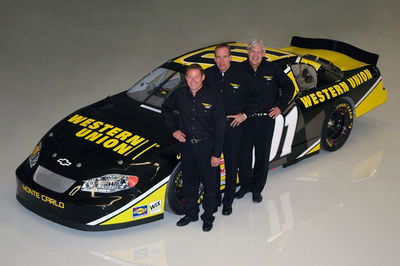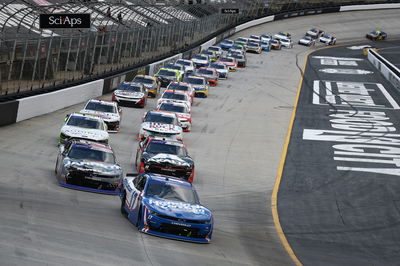Engine man Covey has finger on the button.
Standing in the NASCAR garage next to all the drivers in their brightly coloured uniforms, amidst the ear piercing bark of Chevy's V-8 engines, you wouldn't notice Jim Covey. If you spotted him at all you might think he's just a guy in the garage-possibly a fan, given the smile on his face.
You'd be both right and wrong, for the soft-spoken man listening to the BRRRAP, BRRRAP, BRRRAP of the pushrod V-8s is one of the most influential engine men in the sport today. Certainly it's a claim he'd never let you place on him alone, but it's true.
Standing in the NASCAR garage next to all the drivers in their brightly coloured uniforms, amidst the ear piercing bark of Chevy's V-8 engines, you wouldn't notice Jim Covey. If you spotted him at all you might think he's just a guy in the garage-possibly a fan, given the smile on his face.
You'd be both right and wrong, for the soft-spoken man listening to the BRRRAP, BRRRAP, BRRRAP of the pushrod V-8s is one of the most influential engine men in the sport today. Certainly it's a claim he'd never let you place on him alone, but it's true.
"As a kid, racing was all I ever wanted to do," Covey deadpans.
As it turns out, Covey isn't kidding. A childhood obsession with watching NASCAR on television and racing go-karts eventually brought him to his job today: as the lead engineer in charge of engine development for GM Racing's NASCAR racing activities.
Covey's imprint on the current crop of NASCAR engines in the garage can be seen-or more likely, felt, in the thunder of dozens of Chevy Small-Block V-8 engines used today, although it's virtually impossible to quantify. If one thinks of Covey's role with Chevy's NASCAR engines akin to, say, a Microsoft lead engineer developing an operating system, it's plain to see that his work influences more than just one engine. It influences one engine template, which is then replicated virtually endlessly by each team-each one tweaking and modifying the groundwork from which Covey and his team have laid down.
Is that hundreds of engines? Thousands?
"If you looked at in terms of the components that I've worked on that are used in NASCAR, yes-it would be in the thousands," said Covey. "The big NASCAR engine shops do hundreds of engine builds per year, and we work with all of them."
The development process for Chevrolet's NASCAR engines is complicated but Covey and GM Racing make it simple for their partners. While each team in the garage wants to gain a competitive advantage with their own version of a Chevy Small-Block V-8, Covey and crew work on specific improvements, which are then made available to the group as a whole. It's a research-and-publish process, somewhat like Chevy's version of the New England Journal of Medicine. In this case, the cadavers are victims of abuse in the dynamometer laboratory.
"Instead of each one of our teams trying to do some small project on their own-say, making an improvement in the cooling system-we'll contract with one of our teams and have them do the development. Once we have a sound solution, we'll publish the results to benefit all our teams. It's a fair system for everyone and it's been a huge key to GM's success."
The professional foundation for Covey's love for engines came when he accepted admission to the General Motors Institute (now Kettering University) and spent his time as a co-op student. His senior thesis showed furthermore his fascination, the soberly titled "Analysis of High-Speed Valvetrain in the Corvette GTP prototype." That engine-a Ryan Falconer-designed power plant that made 1,200 hp of Chevrolet power from 3.4-litres-is an achievement of historical proportions. Covey's paper on the engine would prove to be an early connection to the Hendrick Motorsports group, now a famous NASCAR enterprise which ran one of the Corvette GTP cars in the 1980s and was responsible for the majority of its development
"In 1982 I started co-opting with GM in a plant, but knew everything I wanted to do was related to design of engines," recalled Covey. "As it turns out, my sophomore year roommate in college was a guy who worked at Chevrolet Engineering, where Herb Fishel's group was located, so I had a loose connection. I applied for the transfer, and got it.
"I got down to Chevy engineering and had a chance to work in the dyno cells and I was just fascinated by engines. When I was graduating, Herb had this idea that we should get more young engineers in the group. I just happened to be in the right place at the right time. I took it."
Doug Duchardt, former director of GM Racing and now a vice president with Hendrick Motorsports, met Covey in 1986. Duchardt said that Covey has a unique dedication to figuring out what a race engine should be doing on the track.
"The guy has a complete passion for racing," said Doug Duchardt. "The best thing about Jim and the way he works with engines is that he is very sensitive and aware to the needs of a racer-that is, what an engine actually does on the track, not just in the lab. One of the strengths of the GM Racing engine program is the personal relationships he has with the engine people in the NASCAR garage. That's been a great benefit to GM and will continue to be, long term. He's got dedication and a passion that exceeds most in this sport."
Covey began working full-time for GM in its racing group in 1987 and has been a part of the fabric of the organisation ever since. Since then, it's been clear which engine Covey names as his favourite: the Small-Block V-8 that GM created way back in 1955.
"It was an ingenious design, there's no doubt about it," said Covey, almost wistfully. "It's an incredibly versatile package; if you look at some of the other series where you only run at 5 litres as in Trans-Am, yet some of the off-road truck stuff was up to 430 cubic inches. 50 years later we're looking to advance it and we've changed cylinder heads and things like that, but the basic architecture has not changed that much. It's an amazing thing that guys back 50 years could sit down and come up with something that is still used and relevant today. It's really incredible."
Covey's job today means that he's constantly trying to improve on that original V-8 design and conducts monthly meetings with all of Chevy's key partner teams in the NASCAR group. Those are issues of today, but he has to keep a watchful eye on the future.
"A major part of our job is focusing on future engine designs," said Covey. "It's something you can't be complacent on. The SB2 that we race today was introduced to NASCAR in 1996 and wasn't approved until 1998. Ever since then we've been working on other engine packages. Unfortunately we've submitted a few that haven't been approved. But we want to take advantage-if given the opportunity-to submit a new engine, so we've got to have one prepared."
You can bet that Covey has one prepared











